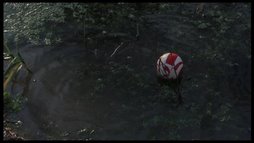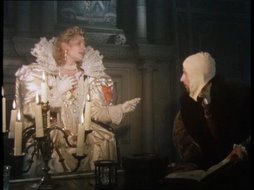
Theo Angelopoulos is widely regarded as one of Greece's greatest cinematic exports, ever the darling of film critics and the festival circuit he has directed a great many classics of European cinema although this has not made him the most widely-seen of filmmakers. One reason is that he personally feels film is for cinema, that films should be seen on the big screen or not at all so the dvd releases of his best films have been hampered initially by his unwillingness to embrace the medium, then simply the matter of getting hold of good quality prints that can be restored and transfered to disc. So far New Star DVD, a Greek company, have released several of his films including The Travelling Players (a copy of which i own) which is now out of print, and some of his better known films like Landscape In The Mist and Ulysses' Gaze; their most recent release - and it should be mentioned here that Angelopoulos personally oversees all transfers of his films at New Star - is his acclaimed political drama-come-satire: Days Of 36.
In 1973,a year after the film was released, Ulrich Gregor interviewed the director for the International Forum des Junges Films, Berlin - an interview which has since been translated to English by Dan Fainaru. Although the interview deals largely with factual elements of the film such as the characters portrayed ("No doubt about [the audience recognising] Metexas")and their relation to 1970s Greek politics ("a time when the actions of the workers' parties were beginning to become effective"), Angelopoulos is particularly enlightening on the production and release of the film. He reveals the film was funded by a husband of a student of one of Theo's filmschool friends (a tenuous link i know) and that the script, daring as it was, was actually slipped past the Greek censors of the time adding the proviso, "to tell you the truth though, thee is quite a bit of difference between the original script and the film in its final form". Angelopoulos is however, unwilling to go into the post-release censorship issues encountred by the film pointing out, "...since i have the intention of continuing to make films in Greece. The main thing is that Days Of 36 was released". In finishing off the interview, when asked about state funding of the film Angelopoulos replies: "Not a penny, but they didn't forget to collect the taxes".
For me, the film is a bit of an oddity. I'm used to his more recent output, his use of long shots and neverending takes, the lack of editing and the prominence of locally-sourced music (courtesy of his regular composer Eleni Karaindrou), but Days Of 36 - part of his 'Historical Trilogy' along with The Travelling Players and The Hunters - is a very different entity indeed.
The film, losely based on real events, concerns a prisoner and a politician. In the opening scene a trade unionist is shot in some type of industrial yard. The shooter [we presume] is sent to prison where a homosexual politican (from the conservative right) visits him in his cell. The prisoner takes the politican hostage at gunpoint causing a political crisis in Greece - how do the government under the military control of Metaxas [leading a right wing military-lead coalition] end the situation in a way that causes the least embarrasment? As the hostage situation stagnates moves are made in the political arena to end the siege, leading finally to a rather down-hearted conclusion.
I said the film is different because stylistically, this is not what i have come to expect from Angelopoulos. The takes are just as long as in any of his other films (in some cases longer) and the use of elongated corridors to enhance the distinctly Brechtian sense of alienation is just as prevalent. However, from the very outset in the opening shot Angelopoulos employs the high-angled camera far more than in any of his other films i've had the pleasure of watching. Usually the camera is at eye level in his work, but in this film he constantly reverts to a quasi-Hitchockian high-angled shot from the corner of the room in which the action takes place. Added to this is the striking use of recessional depth, the likes of which one might associate more with Fassbinder - Angelopoulos talks of Antonioni and Godard as his major influences, "If you are looking for an affinity then it is more in the direction of Godard you should look... At the early stages there was also a touch of Antonioni", plus of admiration for Dreyer although he had only seen one of his films. Using the corridors stretching away from the camera Angelopoulos rarely employs the flatter, "planimetric" staging of his later work (for which people have described his films as like viewing a series of paintings) preferring instead to place his peoples in 3 dimensions using all levels and depths of the frame at once. For those more accustomed to his recent preference for stylish tracking shots that often draw attention to their technical proficiency as much as their aesthetic charm that aspect of his oevre is on display as much here as anywhere else - panning the camera through 2 or 3 complete revolutions goes almost unnoticed amidst the bleakly cinematography and captivating passiveness of the lead actors.
This stained cinematography, combined with the depth staging, lack of editing and sparse dialogue combine to give the film an at once enchanting appeal, counterbalanced by its remote, dramatic sense of alienation, its characters noticeably dislocated from reality. This dislocation is then counteracted by the recognisable faces of some of the politicians, and of the englishmen in the film, plus the sly satirical elements such as the conservative politician's effeminacy - producing a uinique effect of both pulling the audience into the film, and shying them away with the same gesture thus allowing for a more rigorous intellectual debate of the piece. The actors, restrained in their manerisms to the point of tension do what is required by their director - that is to say they do not give bad performances; many modern audiences will not like the distance invoked through their coldness and the lack of characterisation arising from the dearth of dialogue. Yet this is precisely the director's point.
With Days Of 36 he is evoking an atmosphere of political tension under the weight of a dictatorship as much as he is telling a specific story. The fact that a character is a politican is enough without going inot the depth of the character, as the audience in Thessaloniki in 1972 were bringing many preconceptions about the era to the film with them - they knew these people already without being told or shown more. As Angelopoulos says, "what i was looking for was a certain climate. A reign of terror" thus in creating this climate he poses far more questions than he answers. In depicting the "what" and the "when", in alienating the audience through the Brechtian dramatics, he then reengages his viewers on a more intellectual level through posing the question "why?" and by confronting the public with truths that the greek authorities may not have wanted to be widely known (such as the characters being shot by firing squad in the film, which is set at a time when hanging was the public method).
I cannot say this is Angelopoulos' best film as it lacks a lot of the ambition, the scope and, for lack of vocabulary, the "epic feel" of his masterpiece The Travelling Players. Likewise the story is far less charming than Eternity And A Day and perhaps, the politics are less relevant in contemporary Europe than the migration in The Suspended Step Of The Stork but this should not detract from its own merits. For a film made on the cheap, shot quickly largely with an amateur cast (at best he used semi-professional actors) that has only ever had limited distribution, the film examines and satirises an important period of Greek history that has shaped Greek culture ever since. Not a film for those unfamiliar with Angelopoulos' oevre - at least not the best introduction to this very specific mileu, though once you know what to expect and are prepared to give the film a couple of viewings for it to reveal it's nuances and more subtler artistic touches then one can really appreicate it for the important and influential piece of Greek cinema that it truly is.
8/10



.jpg)
.jpg)













